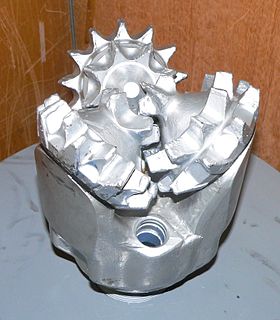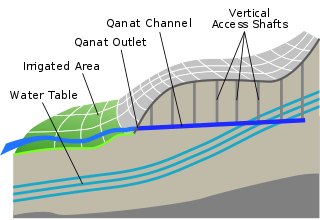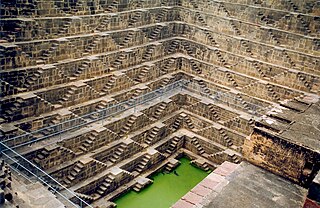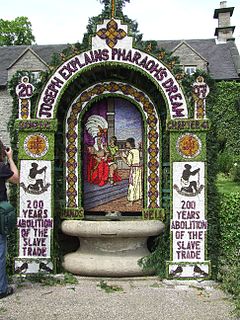 W
WA well is an excavation or structure created in the ground by digging, driving, or drilling to access liquid resources, usually water. The oldest and most common kind of well is a water well, to access groundwater in underground aquifers. The well water is drawn up by a pump, or using containers, such as buckets, that are raised mechanically or by hand. Water can also be injected back into the aquifer through the well. Wells were first constructed at least eight thousand years ago and historically vary in construction from a simple scoop in the sediment of a dry watercourse to the qanats of Iran, and the stepwells and sakiehs of India. Placing a lining in the well shaft helps create stability, and linings of wood or wickerwork date back at least as far as the Iron Age.
 W
WThe 20 Pipe Well is a water well in the Rhineland-Palatinate village of Altleiningen in the northeast of the Palatinate Forest. The well was probably driven around 1600 and was used originally to supply drinking water to Altleiningen Castle on the hill above. Its present design dates to 1855.
 W
WAn artesian aquifer is a confined aquifer containing groundwater under positive pressure. An artesian aquifer has trapped water, surrounded by layers of impermeable rock or clay which apply positive pressure to the water contained within the aquifer. If a well were to be sunk into an artesian aquifer, water in the well-pipe would rise to a height corresponding to the point where hydrostatic equilibrium is reached.
 W
WBaptist well drilling is a very simple, manual method to drill water wells. The Baptist drilling rig can be built in any ordinary arc welding workshop and materials for a basic version costs about 150 US dollars. In suitable conditions, boreholes over 100 m deep have been drilled with this method.
 W
WThe Baths of Chapultepec as a series of deposits used from the pre-Columbian period until the beginning of the 20th century, to houses the waters of the springs of the hill of Chapultepec that served to provide drinking water to Mexico City. Among the remains of these are the so-called Baths of Moctezuma in Chapultepec which was recently remodeled, and the remains of some colonial baths in the Well 5 or Manantial Chico of Chapultepec.
 W
WA brick-lined well is a hand-dug water well whose walls are lined with bricks, sometimes called "Dutch bricks" if they are trapezoidal or made on site. The technique is ancient, but is still appropriate in developing countries where labor costs are low and material costs are high.
 W
WA castle well was a water well built to supply drinking water to a castle. It was often the most costly and time-consuming element in the building of a castle, and its construction time could span decades.
 W
WWell drilling is the process of drilling a hole in the ground for the extraction of a natural resource such as ground water, brine, natural gas, or petroleum, for the injection of a fluid from surface to a subsurface reservoir or for subsurface formations evaluation or monitoring. Drilling for the exploration of the nature of the material underground is best described as borehole drilling.
 W
WThe Etruscan Well, also known as "Sorbello well" from the name of the noble family which still owns the mansion which includes the structure, is located in the old town of Perugia. Entrance to the well, currently open to the public as a museum, is from no. 18 piazza Danti, through a covered walkway which leads to the underground sections of Palazzo Sorbello.
 W
WAmong Eastern Orthodox and Eastern-Rite Catholic Christians, holy water is used frequently in rites of blessing and exorcism, and the water for baptism is always sanctified with a special blessing.
 W
WHydraulic head or piezometric head is a specific measurement of liquid pressure above a vertical datum.
 W
WJacob's Well is a deep well constructed from rock that has been associated in religious tradition with Jacob for roughly two millennia. It is situated a short distance from the archaeological site of Tell Balata, which is thought to be the site of biblical Shechem.
 W
WNested wells, also referred to as nested monitoring wells, are composed of multiple tubes or pipes, typically terminating with short screened intervals (2–3 ft), installed in single boreholes. Sand packs must be installed at the screen depths and seals in the borehole are constructed between the sand packs. Nested wells are different from well clusters in that the latter consists of a cluster of wells where tubes or pipes are constructed in separate, individual boreholes that are drilled and completed at different depths.
 W
WThe Pozzo di San Patrizio is a historic well in Orvieto, Umbria, central Italy. It was built by architect-engineer Antonio da Sangallo the Younger of Florence, between 1527 and 1537, at the behest of Pope Clement VII who had taken refuge at Orvieto during the sack of Rome in 1527 by the Holy Roman Emperor Charles V, and feared that the city's water supply would be insufficient in the event of a siege. The well was completed in 1537 during the papacy of Pope Paul III.
 W
WA puteal is a classical wellhead built around a water well's access opening.
 W
WA qanat or kariz is a gently sloping underground channel to transport water from an aquifer or water well to the surface for irrigation and drinking, acting as an underground aqueduct. Constructed in Iran, Iraq and numerous other societies, this is an ancient system of water supply from a deep well, that makes use of a series of vertical access shafts. The qanats still create a reliable supply of water for human settlements and irrigation in hot, arid, and semi-arid climates, but the value of this system is directly related to the quality, volume, and regularity of the water flow. Traditionally qanats have been built by hand labor in Arab-speaking areas by a group of skilled laborers, known as muqannīs. The profession historically paid well and was typically handed down from father to son.
 W
WThe Ghasabe Qanats of Gonabad, also called Kariz Kai Khosrow, is one of the world's oldest and largest networks of qanats. Built between 700 and 500 BCE by the Achaemenid Empire in what is now Gonabad, Razavi Khorasan Province, Iran, the complex contains 427 water wells with a total length of 33,113 metres (20.575 mi). The site was first added to UNESCO's list of tentative World Heritage Sites in 2007, then officially inscribed in 2016, collectively with several other qanats, as "The Persian Qanat".
 W
WA Ranney Collector is a patented type of radial well used to extract water from an aquifer with direct connection to a surface water source like a river or lake. The amount of water available from the collector is typically related more to the surface water source than to the piezometric surface of the aquifer.
 W
WThe Royal Spring is a well located in Romuald Traugutt Park on Zakroczymska Street in Warsaw. The spring's building was built in the 18th century, with construction beginning in 1770. It is also called the King Stanislaus Augustus Spring. In the 18th century it was very popular with residents of the Warsaw New Town as well as travellers, although the drinking water had to be paid for.
 W
WA shadoof or shaduf is an irrigation tool. It is highly efficient, and has been known since 3000 BCE.
 W
WStepwells are wells or ponds in which the water is reached by descending a set of steps to the water level. They may be multi-storied with a bullock turning a water wheel to raise the well water to the first or second floor. They are most common in western India and are also found in the other more arid regions of the Indian subcontinent, extending into Pakistan. The construction of stepwells is mainly utilitarian, though they may include embellishments of architectural significance, and be temple tanks.
 W
WA tube well is a type of water well in which a long, 100–200 millimetres (3.9–7.9 in)-wide, stainless steel tube or pipe is bored into an underground aquifer. The lower end is fitted with a strainer, and a pump lifts water for irrigation. The required depth of the well depends on the depth of the water table.
 W
WThe Turpan water system or Turfan water system in Turpan, located in the Turpan Depression, Xinjiang, China, is a vertical tunnel system adapted by the Turpan people. The word karez means "well" in the local Uyghur language. Turpan has the Turpan Water Museum dedicated to demonstrating its karez water system, as well as exhibiting other historical artifacts.
 W
WA well cluster, also referred to as a monitoring well cluster, consists of multiple co-located monitoring wells that are constructed with intakes at different depths in the subsurface. The purpose of a well cluster is to provide groundwater samples from discrete depths at approximately the same location. Also, water levels can be measured in each individual monitoring well, providing vertical profiles of groundwater pressure. Well clusters are different from nested wells in that each monitoring well is constructed in a separate borehole, as opposed to multiple well casings in a single borehole which is the case with nested wells). A key advantage of a well cluster over a nested well is that there is less potential for vertical leakage and hydraulic short-circuiting because reliable annular seals are installed in each separate borehole in the cluster. However, well clusters require drilling multiple boreholes, which results in higher construction costs compared to nested wells. Economical alternatives to well clusters are multilevel groundwater monitoring systems, also referred to as engineered nested wells.
 W
WWell dressing, also known as well flowering, is a tradition practised in some parts of rural England in which wells, springs and other water sources are decorated with designs created from flower petals. The custom is most closely associated with the Peak District of Derbyshire and Staffordshire. James Murray Mackinlay, writing in 1893, noted that the tradition was not observed in Scotland; W. S. Cordner, in 1946, similarly noted its absence in Ireland. Both Scotland and Ireland do have a long history of the veneration of wells, however, dating from at least the 6th century.
 W
WThe Well of Dina Nath was intended to be a water well in the Wazir Khan Chowk in Lahore, Pakistan. The well's construction by in the 19th century by a Sikh nobleman sparked controversy, given its location in the immediate vicinity of the Wazir Khan Mosque.
 W
WA windpump is a type of windmill which is used for pumping water.
 W
WA wishing well is a term from European folklore to describe wells where it was thought that any spoken wish would be granted. The idea that a wish would be granted came from the notion that water housed deities or had been placed there as a gift from the gods. This practice is thought to have arisen because water is a source of life, and was often a scarce commodity.